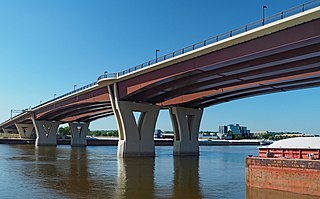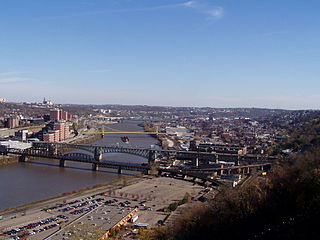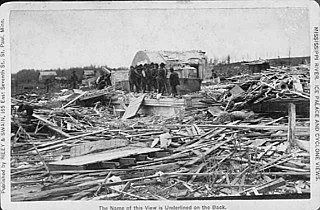This article relies largely or entirely on a single source .(January 2016) |
Sauk Rapids Regional Bridge | |
|---|---|
 Construction of the Sauk Rapids Regional Bridge as of August 18, 2006, shown from the west bank of Mississippi River, south of the bridge. | |
| Coordinates | 45°35′17″N94°10′12″W / 45.58806°N 94.17000°W |
| Carries | Four lanes connecting Second Street North (Benton CSAH 3), Sauk Rapids, MN and Ninth Avenue North, St. Cloud, MN, pedestrians |
| Crosses | Mississippi River, BNSF Railway |
| Locale | Sauk Rapids, Minnesota |
| Official name | Sauk Rapids Regional Bridge |
| Maintained by | Stearns County, City of Sauk Rapids |
| ID number | 05534 |
| Characteristics | |
| Design | Plate girder bridge |
| History | |
| Opened | October 23, 2007 |
The Sauk Rapids Regional Bridge is a bridge spanning the Mississippi River in the U. S. city of Sauk Rapids, Minnesota. Construction began on September 26, 2005; the bridge was completed in September 2007 and opened to traffic on October 23, 2007. The official dedication and ribbon-cutting ceremony took place on November 16, 2007. The bridge replaced the former Sauk Rapids Bridge, located a short distance downriver, which was demolished in the fall and winter of 2007-2008.

The Mississippi River is the second-longest river and chief river of the second-largest drainage system on the North American continent, second only to the Hudson Bay drainage system. Its source is Lake Itasca in northern Minnesota and it flows generally south for 2,320 miles (3,730 km) to the Mississippi River Delta in the Gulf of Mexico. With its many tributaries, the Mississippi's watershed drains all or parts of 32 U.S. states and two Canadian provinces between the Rocky and Appalachian mountains. The main stem is entirely within the United States; the total drainage basin is 1,151,000 sq mi (2,980,000 km2), of which only about one percent is in Canada. The Mississippi ranks as the fourth-longest and fifteenth-largest river by discharge in the world. The river either borders or passes through the states of Minnesota, Wisconsin, Iowa, Illinois, Missouri, Kentucky, Tennessee, Arkansas, Mississippi, and Louisiana.

Sauk Rapids is a city in Benton County, Minnesota, United States. The population was 12,773 at the 2010 census and is 13,879 according to 2018 census estimates. It is located on a set of rapids on the Mississippi River near its confluence with the Sauk River.

The Sauk Rapids Bridge was a steel spandrel braced arch bridge that spanned the Mississippi River between the cities of St. Cloud and Sauk Rapids in the U.S. state of Minnesota. It was built in 1942 and was designed by the Minnesota Department of Transportation. The bridge consisted of three spans supported by two piers. It crossed the Mississippi River one-half mile (0.8 km) downstream from the rapids of the Sauk River. The river is still rough and fast-flowing at this location.
The new bridge spans the BNSF Railway on the east bank of the river. Traffic flow is no longer disrupted during train crossings; this was a frequent problem with the former bridge.

The BNSF Railway Company is the largest freight railroad network in North America. One of eight North American Class I railroads, BNSF has 44,000 employees, 32,500 miles (52,300 km) of track in 28 states, and more than 8,000 locomotives. It has three transcontinental routes that provide rail connections between the western and eastern United States. BNSF trains traveled over 169 million miles in 2010, more than any other North American railroad. The BNSF and Union Pacific have a duopoly on all transcontinental freight rail lines in the Western U.S. and share trackage rights over thousands of miles of track.
The new span relied heavily on steel for its construction rather than concrete to reduce the number of piers needed to be placed in the river. This design choice increased the project cost by $2.3 million USD to a total cost estimated at $56.63 million. Construction of the bridge of itself cost an estimated $20.46 million, with other costs including right-of-way purchases, road construction, and a program to help businesses affected by the project relocate elsewhere in downtown Sauk Rapids.
The entire project was large in scope, due to the amount of business and residential properties that were affected by its chosen location. When the Sauk Rapids Bridge project began, it was considered to be the first downtown transportation project of its kind nationwide in terms of the scale of relocations of businesses that were necessary. The success of the project may set a precedent for future bridges. [1]
The original design of the bridge was hotly contested between Benton County and the City of Sauk Rapids, and the dispute was nearly taken to court. The county had wished that the bridge land beyond Benton Drive (Sauk Rapids' "main street") on Second Avenue and connect with Second Street North. The city feared that such a design would adversely affect businesses in the downtown area and desired instead that the bridge land on Benton Drive. Benton County's stake in the project (Stearns County being the other contributor) was eventually handed over to the city, and it was elected that the bridge pass over the BNSF Railway, land on Benton Drive, and connect with Second Street North.

Benton County is a county in the U.S. state of Minnesota. As of the 2010 United States Census, the population was 38,451. Its county seat is Foley. Established in 1849 and organized in 1850, the county is one of the oldest in Minnesota. It was named for Thomas Hart Benton, a United States Senator from Missouri.

Stearns County is a county in the U.S. state of Minnesota. As of the 2010 United States Census, the population was 150,642. Its county seat is Saint Cloud. The county was founded in 1855. It was originally named for Isaac Ingalls Stevens, then renamed for Charles Thomas Stearns.
The Sauk Rapids Regional Bridge features a spiral walkway on the Sauk Rapids side of the bridge that allows pedestrians to access the city parking lot under the bridge.














